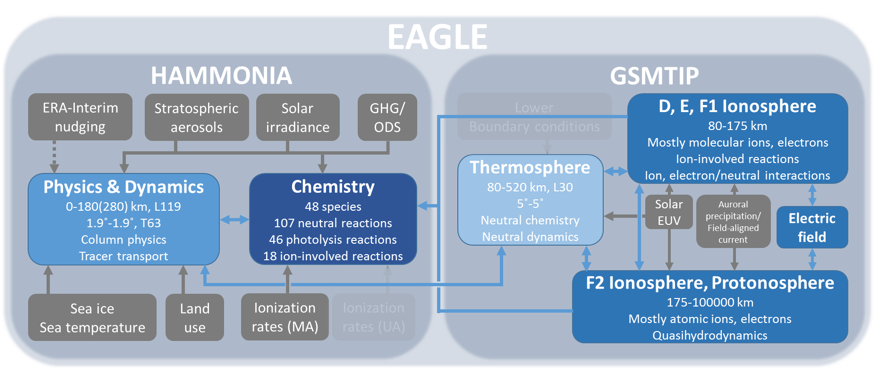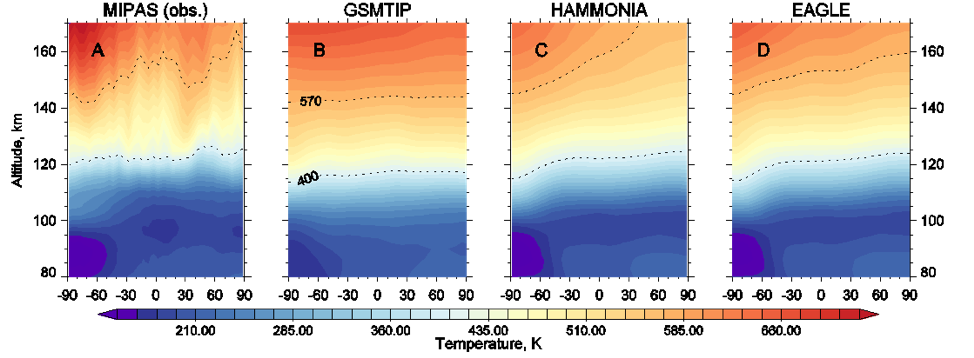Entire Atmosphere Global Model (EAGLE)
Involved group members: external page Timofei Sukhodolov (WRC/PMOD Davos),external page Eugene Rozanov (WRC/PMOD Davos)

The Earth's ionosphere is a complex system of coupled dynamical, radiative and chemical processes. Ionospheric variability is mostly defined by the solar radiation flux and geomagnetic activity, but still a significant part of it (~20%) is associated with the forcing coming from the lower and middle atmosphere. Main mechanisms responsible for this connection are planetary waves, atmospheric tides, and gravity waves. A proper representation of all these processes is crucial for understanding the ionosphere itself and its connection to the lower layers. Historically, numerical models of the upper atmosphere layers (>80 km) and the lower atmosphere layers (<80 km) progressed almost independently just prescribing the lower/upper boundary conditions, which is usually a very rough approximation of all the physics happening below/above. With a rising knowledge about atmospheric sciences related to progress, both, in measurements and models, it became clear that interrelation between atmospheric layers is important and needs to be addressed explicitly. This project is a step in this direction devoted to the development and application of the new Entire Atmosphere Global Model (EAGLE) that combines models of the upper and the lower atmosphere.
To calculate the state and variability of the lower and middle atmosphere, we use the HAMMONIA model (Hamburg Model of the Neutral and Ionized Atmosphere). This model is mostly based on the fifth version of the general circulation model of the atmosphere ECHAM5, but also contains several important additions, such as the extension of the top boundary up to 250 km, inclusion of the chemical module MOZART3, and others, which allow a good representation of the lower thermosphere. State and variability of the upper atmosphere are calculated by the GSMTIP model (Global Self-consistent Model of the Thermosphere, the Ionosphere and the Protonosphere). This model is based on the system of quasi-hydrodynamic equations of continuity, motion and heat balance for neutral and charged particles of the cold near-earth plasma in conjunction with the equation for the electric potential in the altitude range from 80 km to geocentric distance of ~15 earth radii, thus, fully describing the ionosphere.
For coupling the two models, we programmed a coupler interface that prepares fields of both models to be transited to each other in the overlap region and allows to run parallel (HAMMONIA) and non-parallel (GSMTIP) codes simultaneously. HAMMONIA provides neutral temperature and wind fields in the 80-120 km region, which is defined by gravity waves activity, and number densities of air, O, N, and NO at 80 km, while GSMTIP shares the results of ion-neutral interactions (Joule heating and ion drag tendencies) in the 80-250 km region. The new combined model already demonstrates better representation of the mean state of the thermosphere and the ionosphere than calculated by discrete models, as well as better behavior of the ionospheric parameters under dynamically perturbed conditions of the strong sudden stratospheric warming of January 2009. Further model tests and applications are in progress.
